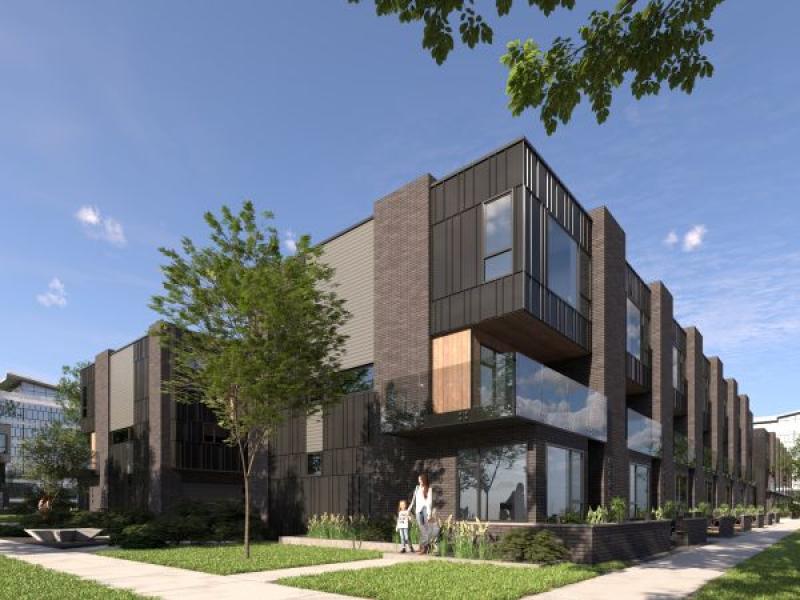
The triple whammy of high demand and building costs, plus elevated interest rates will impact the housing industry across most of Canada through 2024, offering no relief to Canadians seeking entry into the housing market, Canada Mortgage and Housing Corporation (CMHC) predicts.
In its updated and expanded Housing Market Outlook report analyzing the trends in Canada’s national and regional housing markets, the CMHC anticipates persistently higher interest rates will challenge all segments of the market, including the rental sector.
The Crown housing corporation blames the high cost of home ownership and a slowdown in construction of rental housing in many markets - both factors which are affected by the interest rate environment.
The CMHC also expects these trends to continue increasing the level of pent-up ownership demand, which it predicts will push prices beyond previous peak levels when interest-rate relief does arrive, indicating “a lack of short-term affordability improvement.”
Such trends are indicative of a broader slowdown in the national economy, the CMHC says, as it forecasts minimal gains in 2024. The CMHC does see a potentially brighter 2025 to 2026 on the economic front, anticipating an easing of the cost of borrowing that will stimulate the economy, and lead to a slight improvement in housing starts.
Recovery from a slow 2024
Interest rate hikes to cool the economy and inflation have stifled the housing industry and accessibility, CMHC states. Mortgage rates, financing for housing projects and starts for purpose-built rentals have all been impacted, increasing the financial strains for potential buyers and investors.
Apartment starts are expected to be slowed in 2024, despite the elevated pressure on rental housing. Additional factors include labour shortages and rising construction costs.
It is not just rental housing that has been challenged, the CMHC says. Single-detached starts have also fallen since 2021.
Despite the gloomy news, including anticipated weak GDP growth in 2024, the CMHC sees signs of a return in the next two years.
Inflation is predicted to decline to the mid two-per-cent range by mid-2024 and continue to fall until it is in the low two-per-cent range in 2025 to 2026. In response, interest rates would also follow, allowing for more homebuilding activity bolstered by easier financing, elevated consumer confidence, rising real incomes and more government support.
But affordability problems will not be eased, the CMHC predicts. The MLS average price in the resale market, for a baseline economic scenario, is expected to reach new heights rising from $678,282 in 2023 to a forecast of $814,851 in 2026.
Demand for rentals will also remain high as a result, combined with sustained population growth from immigration.
“We anticipate an increase in purpose-built rental completions over the forecast horizon due to the record number of projects started in 2021 to 2023. However, this increase will not meet the growing demand. As a result, rental markets will remain tight, particularly in the pricier areas of Canada,” CMHC states.
Regional trends vary
On a local scale, the CMHC forecasts a range of different conditions in markets across Canada.
Ontario and British Columbia, already home to the nation's priciest housing on average, will drive the decline in national housing starts for 2024. In Toronto and Hamilton, this is expected to affect apartments the most; in Vancouver, multifamily buildings.
Toronto housing starts for single-detached and multifamily buildings are projected to dip from over 47,400 in 2023 to the highest estimates of 39,000 in 2024, 35,000 in 2025 and 42,000 in 2026.
In Ottawa, the trend is to an increase in multi-unit housing starts in 2024 due to “declining financing costs, easing inflation and policies aimed at reducing development costs.” Housing prices in the capital are expected to rise from 2024 to 2026 — from an average of $654,795 in 2023 to as much as $775,000 in 2026. Population growth stimulated by the city’s tech sector and migration will likely worsen housing affordability, CMHC writes.
Montreal is teed up for more investment into housing after a challenging 2022 and 2023, the report states. Rental price hikes are expected in 2024 due to a projected decrease in vacancy rates. In 2023, the vacancy rate stood at 1.5 per cent. By 2026, the CMHC expects 0.9 per cent.
The rosiest outlook went to the Western and Prairie provinces due to housing affordability, steady population growth and robust economics.
Edmonton and Calgary are seeing strong housing start numbers; and Regina and Saskatoon are set for higher housing demand. But the regions will also not be immune to tight rental market conditions, the CMHC adds. Calgary, for example, is forecast for a vacancy rate of 1.1 per cent in 2024 and one per cent in 2025, compared to 1.5 per cent in 2023.
After a period of “unusually strong migration in 2022 to 2023,” pressure for new home construction is projected to fall in Atlantic Canada, the CMHC says. Despite Halifax being forecast for housing starts, home prices and home sales to increase from 2024 to 2026, the numbers will “realign more closely with weaker population growth over the forecast period.”
Like the rest of Canada, the CMHC also anticipates Atlantic Canada to see an increase in rents, even with a record number of rental units being built and eventually completed.










